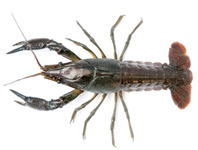Abstract
A new species of peppermint shrimp, Lysmata baueri n. sp., is described based on a single specimen from the eastern Gulf of Mexico. The new species can be distinguished from other morphologically similar species of Lysmata Risso, 1816 by the number of teeth, length and shape of the rostrum, the length of the antennular peduncle relative to the scaphocerite, the number of meral and ischial articles in the second pereiopods, and the number of spines on the flexor margin of the dactyli from the third to fifth pereiopods. Morphological characters demonstrate that L. baueri n. sp., is most closely related to the eastern Pacific L. californica (Stimpson, 1866), L. nayaritensis Wicksten, 2000 and L. porteri (Rathbun, 1907).
References
Anker, A. & Cox, D. (2011) A new species of the shrimp genus Lysmata Risso, 1816 (Crustacea, Decapoda) from Guam. Micronesica, 41 (2), 197–214.
Baeza, J.A. (2006) Testing three models on the adaptive significance of protandric simultaneous hermaphroditism in a marine shrimp. Evolution, 60, 1840–1850.
https://doi.org/10.1111/j.0014-3820.2006.tb00527.xBaeza, J.A. (2007a) Male mating opportunities affect sex allocation in a protandric simultaneous hermaphroditic marine shrimp. Behavioral Ecology and Sociobiology, 61, 365–370.
https://doi.org/10.1007/s00265-006-0265-2Baeza, J.A. (2007b) No effect of group size on sex allocation in a protandric-simultaneous hermaphroditic shrimp. Journal of the Marine Biological Association of the United Kingdom, 87, 1169–1174.
https://doi.org/10.1017/S0025315407057542Baeza, J.A. (2007c) Sex allocation in a simultaneously hermaphroditic marine shrimp. Evolution, 61, 2360–2373.
https://doi.org/10.1111/j.1558-5646.2007.00199.xBaeza, J.A. (2008) Protandric simultaneous hermaphroditism in the shrimps Lysmata bahia and L. intermedia. Invertebrate Biology, 127, 181–188.
https://doi.org/10.1111/j.1744-7410.2007.00122.xBaeza, J.A. (2009) Protandric simultaneous hermaphroditism is a conserved trait in Lysmata (Caridea: Lysmatidae): implications for the evolution of hermaphroditism in the genus. Smithsonian Contributions to Marine Science, 38, 95–110.
Baeza, J.A. (2013) Molecular phylogeny of broken-back shrimps (genus Lysmata and allies): A test of the ‘Tomlinson–Ghiselin’ hypothesis explaining the evolution of hermaphroditism. Molecular Phylogenetics and Evolution, 69, 46–62.
https://doi.org/10.1016/j.ympev.2013.05.013Baeza, J.A. & Bauer, R.T. (2004) Experimental test of socially mediated sex change in a protandric simultaneous hermaphrodite, the marine shrimp Lysmata wurdemanni (Caridea: Hippolytidae). Behavioral Ecology and Sociobiology, 55, 544–550.
https://doi.org/10.1007/s00265-003-0744-7Baeza, J.A., Reitz, J. & Collin, R. (2008) Protandric simultaneous hermaphroditism and sex ratio in the shrimp Lysmata nayaritensis. Journal of Natural History, 41, 2843–2850.
https://doi.org/10.1080/00222930701770778Baeza, J.A., Schubart, C.D., Zillner, P., Fuentes, S. & Bauer, R.T. (2009) Molecular phylogeny of shrimps from the genus Lysmata (Caridea: Hippolytidae): the evolutionary origins of protandric simultaneous hermaphroditism and pair-living. Biological Journal of the Linnean Society, 96, 415–424.
https://doi.org/10.1111/j.1095-8312.2008.01133.xBaeza, J.A., Gueron, R., Simpson, L. & Ambrosio, L.J. (2016) Population distribution, host-switching, and chemical sensing in the symbiotic shrimp Lysmata pederseni: implications for its mating system in a changing reef seascape. Coral Reefs, 35, 1213–1224.
https://doi.org/10.1007/s00338-016-1467-3Bauer, R.T. & Holt, G.J. (1998) Simultaneous hermaphroditism in the marine shrimp Lysmata wurdemanni (Caridea: Hippolytidae): an undescribed sexual system in the decapod Crustacea. Marine Biology, 132, 223–235.
https://doi.org/10.1007/s002270050388Bauer, R.T. & Newman, W.A. (2004) Protandric simultaneous hermaphroditism in the marine shrimp Lysmata californica (Caridea: Hippolytidae). Journal of Crustacean Biology, 24, 131–139.
https://doi.org/10.1651/C-2426Braga, A.A., López-Greco, L.S., Santos, D.C. & Fransozo, A. (2009) Morphological evidence for protandric simultaneous hermaphroditism in the caridean Exhippolysmata oplophoroides. Journal of Crustacean Biology, 29, 34–41.
https://doi.org/10.1651/08.3015.1Bruce, A.J. (1983) Lysmata debelius, new species, a new hippolytid shrimp from the Philippines. Revue Francaise d’Aquariologie et Herpetologie, 4, 115–120.
Burukovsky, R.N. (2000) Lysmata splendida sp. nov., a new species of shrimp from the Maldives (Crustacea: Decapoda: Hippolytidae). Senckenbergiana maritima, 30, 223–227.
https://doi.org/10.1007/BF03042966Dana, J.D. (1852) Crustacea. United States Exploring Expedition during the years 1838, 1839,1840, 1841, 1842; under the command of Charles Wilkes, 13, 1–1620.
De Man, J.G. (1888) Bericht über die von Herrn Dr. J. Brock im indischen Archipel gesammelten Decapoden und Stomatopoden. Archiv für Naturgeschichte, 53 (3), 289–600, pls. 11–22a.
Fiedler, G.C. (1998) Functional, simultaneous hermaphroditism in female-phase Lysmata amboinensis (Decapoda: Caridea: Hippolytidae). Pacific Science, 52, 161–169.
Gibbes, L.R. (1850) On the carcinological collections of the United States, and an enumeration of species contained in them, with notes on the most remarkable, and descriptions of new species. Proceedings of the American Association for the Advancement of Science, 3, 165–201.
Gordon, I. (1935) On new and imperfectly known species of Crustacea Macrura. The Journal of the Linnean Society, Zoology, 39, 307–351.
https://doi.org/10.1111/j.1096-3642.1935.tb00075.xLaubenheimer, H. & Rhyne, A.L. (2010) Lysmata rauli, a new species of peppermint shrimp, (Decapoda: Hippolytidae) from the southwestern Atlantic. In: De Grave, S. & Fransen, C.H.J.M. (Eds.), Contributions to shrimp taxonomy. Zootaxa, 2372, 298–304.
Limbaugh, C., Pederson, H. & Chace, F.A. Jr. (1961) Shrimps that clean fishes. Bulletin of Marine Science, 11, 237–57.
Rathbun, M.J. (1900) Results of the Branner-Agassiz Expedition to Brazil. I. The decapod and stomatopod Crustacea. Proceedings of the Washington Academy of Sciences, 2, 133–156.
Rathbun, M.J. (1907) South American Crustacea. Revista Chilena de Historia Natural, 11, 45–50, pls. 2–3.
Rhyne, A.R. & Anker, A. (2007) Lysmata rafa, n. sp., a new species of peppermint shrimp (Crustacea, Caridea, Hippolytidae) from the subtropical western Atlantic. Helgoländer Marine Research, 61, 291–296.
https://doi.org/10.1007/s10152-007-0077-4Rhyne, A.L. & Lin, J. (2006) A western Atlantic peppermint shrimp complex: re-description of Lysmata wurdemanni, description of four new species, and remarks on Lysmata rathbunae (Crustacea: Decapoda: Hippolytidae). Bulletin of Marine Science, 79, 165–204.
Rhyne, A.L., Calado, R. & dos Santos, A. (2012) Lysmata jundalini, a new peppermint shrimp (Decapoda, Caridea, Hippolytidae) from the Western Atlantic. Zootaxa, 3579, 71–79.
Risso, A. (1816) Histoire Naturelle des Crustacés des Environs de Nice. Librairie GrecqueLatine-Allemande, Paris, 175 pp., 3 pls.
Stimpson, W. (1866) Descriptions of new Genera and Species of Macrurous Crustacea from the Coasts of North America. Proceedings of the Chicago Academy of Sciences, 1, 46–48.
d’Udekem d’Acoz, C. (2003) Lysmata seticaudata (Risso, 1816) and L. nilita Dohrn & Holthuis, 1950 are protandrous simultaneous hermaphrodites (Decapoda, Caridea, Hippolytidae). Crustaceana, 75, 1149–1152.
https://doi.org/10.1163/156854002763270545Wicksten, M. (2000) The species of Lysmata (Caridea: Hippolytidae) from the Eastern Pacific Ocean. Amphipacifica, 11 (4), 3–22.

